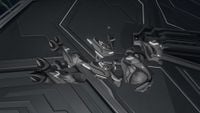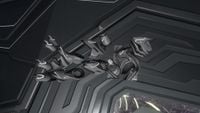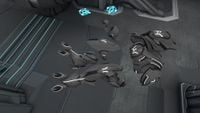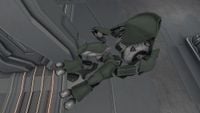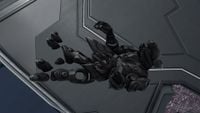Armor customization (Halo Online)
From Halopedia, the Halo wiki
Armor permutations in Halo Online allow players to customize their Spartan and Elite player model. Players can purchase individual armor pieces with in-game currency similar to Halo: Reach.
List of permutations
Spartans
Below is a list of armor by the build of Halo Online they were in.
Halo Online Announce Trailer
This is a list of armor that was seen in the Halo Online Announce Trailer, with notes about them.
- BOXHEAD used the RANGER-class Mjolnir design.
- IRON used the WAR MASTER-class Mjolnir design.
- PILOT used the OPERATOR-class Mjolnir design.
- The following armor share both their name and design with their canon counterparts, SOLDIER-class Mjolnir, EOD-class Mjolnir, ROGUE-class Mjolnir, and SCOUT-class Mjolnir.
- Valery-sturm-buzz.jpg
Development image of BUZZSAW
- Cain Parts HO.png
CAIN
Pre Alpha
This is a list of armor descriptions that was found in the code of the Alpha of Halo Online.
- TREMOR: TREMOR-variant armor removes several layers of the Mjolnir's threat management and safety interlocks, allowing programmable grenades to be set to higher yields.
Intended for defensive operations, Spartan training has instead tested the TREMOR's offensive utility.
- PIONEER: Though further refinements are expected, Acheron Security has staked the reputation of its Military Sensors Division on the PIONEER's advanced threat detection system.
The PIONEER testbed is the first of a new series of post-War reconnaissance and combat expedition Mjolnir variants.
- AIR ASSAULT: Based on a proven Ushuaia Armory design, Naphtali hopes to leverage the AIR ASSAULT's all-around excellent performance and combat endurance to compete for the UNSC's lucrative Spartan recruit armor contract. AIR ASSAULT armor is a front-runner for the standard armor that future Spartans will be clad in.
- GUNSLINGER: The GUNSLINGER design is unusual in that it is being built around the requirements of UEG police forces, with a tweaked smart-link system to increase handgun accuracy.
GUNSLINGER is testing the potential for Mjolnir technology in a broader market.
- ORACLE: More an integrated experiment than a fully-realized Mjolnir variant, the ORACLE is testing a host of improvements in energy recuperation and power-distrubution subsystems for eventual inclusion in a standalone tactical package. ORACLE is a test platform for modular system upgrades planned for the final GEN2 suits.
- JUGGERNAUT: The JUGGERNAUT's design was thought lost during the fall of Reach. Recovered by a corporate scout team in 2553, the prototype helmets were paired with a GEN2 prototype harness and shipped to Anvil Station for integration testing. 2553 Each JUGGERNAUT helmet is dabbed with vitrified dirt from Reach as a reminder of what is at stake.
- HOPLITE:Initially designed as an alternative to the SPI armor used by SPARTAN-III operatives, the notoriously secretive Watershed group has unexpectedly revealed the HOPLITE as a low-cost Mjolnir variant optimized for pairing with UNSC pistols.-III. HOPLITE armor lacks the bells and whistles of most Mjolnir variants, but is easy to build and repair.
- BREAKER: The BREAKER is a no-nonsense Mjolnir variant being marketed as a "tactical supremacy" design, with increased endurance in the field, battle-tested components, and compatibility with the full range of tactical packages now available. Lethbridge Industrial has entered this design into the Spartan branch armor competition.
- SPECTRUM: All business in design, the SPECTRUM-class Mjolnir armor is designed to get up close and personal with Covenant forces inside their starships and destroy them using high explosives and pinpoint gunfire.
Cascade is aggressively marketing potential variants of the SPECTRUM design to police and paramilitary forces.
- CALADCHOLG: Not intended for mass production, the CALADCHOLG was designed and manufactured simply to demonstrate a new design for fast-switching Mjolnir muscle fibers, which allow for quick return to a combat posture after sprinting. CALADCHOLG was built by a secretive design group within Materials Group as a technology demonstrator.
- VOID DANCER: Hardened against the perils of exoatmospheric operation and equipped with the latest threat assessment firmware, the VOID DANCER is Acheron's entry for the ODST's Generation After Next armor upgrade competition. Costly and tempermental, the VOID DANCER is a risky gambit for Acheron in the UNSC's post-2552 "procurement wars."
- CYCLOPS: A product of IMC's secretive Io Design Lab, small superconducting loops spaced throughout the CYCLOPS subassembies and a more powerful fusion power pack give a substantial edge in fights that make use of tactical packages. A stripped-down version of the CYCLOPS power system is being tested for use as a backpack-carried energy source for UNSC energy weapons.
- COMMANDO: Though it has the rights to the design of Chalybs Defense Solutions original Mk V/K armor, Naphtali has adopted the COMMANDO name for a new design fitted with high-capacity energy banks for extended tactical package usage. Mk V/K Marketed on the excellent reputation of the original COMMANDO, the new design has yet to prove itself.
- OMNI: A surprisingly effective composite of other Acheron Security designs, the OMNI is currently the company's cutting-edge Mjolnir suit, and one of the few able to effectively use Material Groups GEN2 prototype sensor suite. Petabytes of Mjolnir combat data have been carefully sifted and analzed by Acheron researchers to inform the OMNI's design.
- REAPER: Considered an early work-in-progress by Hannibal's design team, the REAPER-class armor still requires substantial refactoring of its interface system and stabilization of the tactical pack power feeds.
Even this early version has drawn considerable praise from the testers at Anvil Station.
- WIDOWMAKER: High-threat dynamic combat actuation is the WIDOW MAKER's raison d'tre. With hardwired response protocols and quick-release mag-clamps the operator can quickly assess the situation and use the most appropriate weapon at hand. Testers at Anvil Station have noted the Widow Maker seems best suited for operation in human built-up areas.
- VENATOR: VENATOR is Lethbridge Industrial's flagship GEN2 prototype, incorporating high-performance power systems and hardwired CQB protocols. Apex predator of the advanced Mjolnir protoypes being tested at Anvil Station.
- MIRMILLON: Taking form defining function to an extreme, RKD's MIRMILLON-class armor optimizes combat flexibility by using best-in-class tactical package components that require less power to charge. Rumors persist among Anvil Station personnel of MIRMILLON units fitted with hardlight shields.
- SCEPTRE: Though capable of efficiently utilizing the new modular tactical package system, Lethbridge has also modified several SCEPTRE suits to use the alternative plug-in upgrade system championed by Materials Group. The SCEPTRE belongs to a new family of Mjolnir-based armor systems.
- RENEGADE: Obstentially a strategic reconnaissance variant, users have noticed the RENEGADE's sensor suite is calibrated specifically to track other Mjolnir suits; particularly those featuring emissions cloaking.
ONI seems particularly interested in the testers' combat performance against other Spartans.
- FLENSER: The FLENSER design is so new that final fabrication took place on Anvil Station itself, conveniently bypassing several testing protocols in the process. It remains to be seen how stable the suits new low-power muscle fiber system is, as the first prototype burned itself out after a single War Games match. Though its running endurance is top-class, concerns remain about the FLENSER's viability in the field.
- INQUISITOR: INQUISITOR-class armor does not utilize a fusion reactor, instead relying on an intact Forerunner Sentinel power cell. This allows for incredible flexibility in reallocating power to critical tactical packages. Custom-built Mjolnir frame with salvaged Forerunner power supply.
- RAMPART: The RAMPART armor system is one of several armor system prototypes from Materials Group which are tailored for operation in built-up areas, such as urban areas and space habitats. The RAMPART is particularly well-suited for hunter-killer operations in cramped arcologies. High-threat combat actuation in urban environments is assumed to be the default battleground for Spartan-IV graduates.-IV.
- INFILTRATOR: INFILTRATOR-class armor is a new class of Mjolnir armor, created to subvert and penetrate security systems at heavily fortified sites which require on-site taps. To facilitate this, the suit has a faster recovery period after evading enemy patrols and sensors with sprint. The tactical abilities of the INFILTRATOR will be tested at Anvil Station, the cyberintrusion protocols are undergoing review on New Carthage.
- HALBERD: Cloaked in secrecy, all users of the HALBERD-class armor must sign binding non-disclosure agreements about its performance and the particulars of its new weapon mag-lock arrangement. Emerson guards the HALBERD prototype suits with their own - heavily armed - private security.
- STRIDER: With its extended-range sensors, the STRIDER was paired with prototype suits that lacked their full combat suite during the desperate defense of Concord in 2551. Now finalized, the suit is undergoing final testing at Anvil Station. 2551 Closely related to the VENATOR-class armor.
Below is a gallery of armor found in the alpha build code.
- Stealth uses the VENATOR-class Mjolnir design.
- The following armor share both their name and design with their canon counterparts, DEFENDER-class Mjolnir.
Alpha
This is a list of armor that was found in the Alpha of Halo Online.
- The following armor had their names changed from the Pre-alpha: Widowmaker to Vdovodel, Dutch to Shiver, Orbital to Emptiness, Ballista to Cyclops.
- Halo Online Valery-sturm-dutch.jpg
Shiver development
Beta
This is a list of armor that was available in the Beta of Halo Online.
- Saboteur used the INFILTRATOR-class Mjolnir design.
- Landing used the AIR ASSAULT-class Mjolnir design.
- The following armor had their names changed since the previous builds: Scanner to Shooter, Wrestler to Fighter, Air Assault to Landing, Strider to Aspex, Spectrum to Ghost, Emptiness to Stranger, GUNGNIR to Kaladbolg, Hammerhead to Commando.
- Early Halo Online modelValery-sturm-explorer.jpg
Development fighter
Elites
Here is a gallery of some of the unreleased Halo Online Elite armor.
Gallery















































